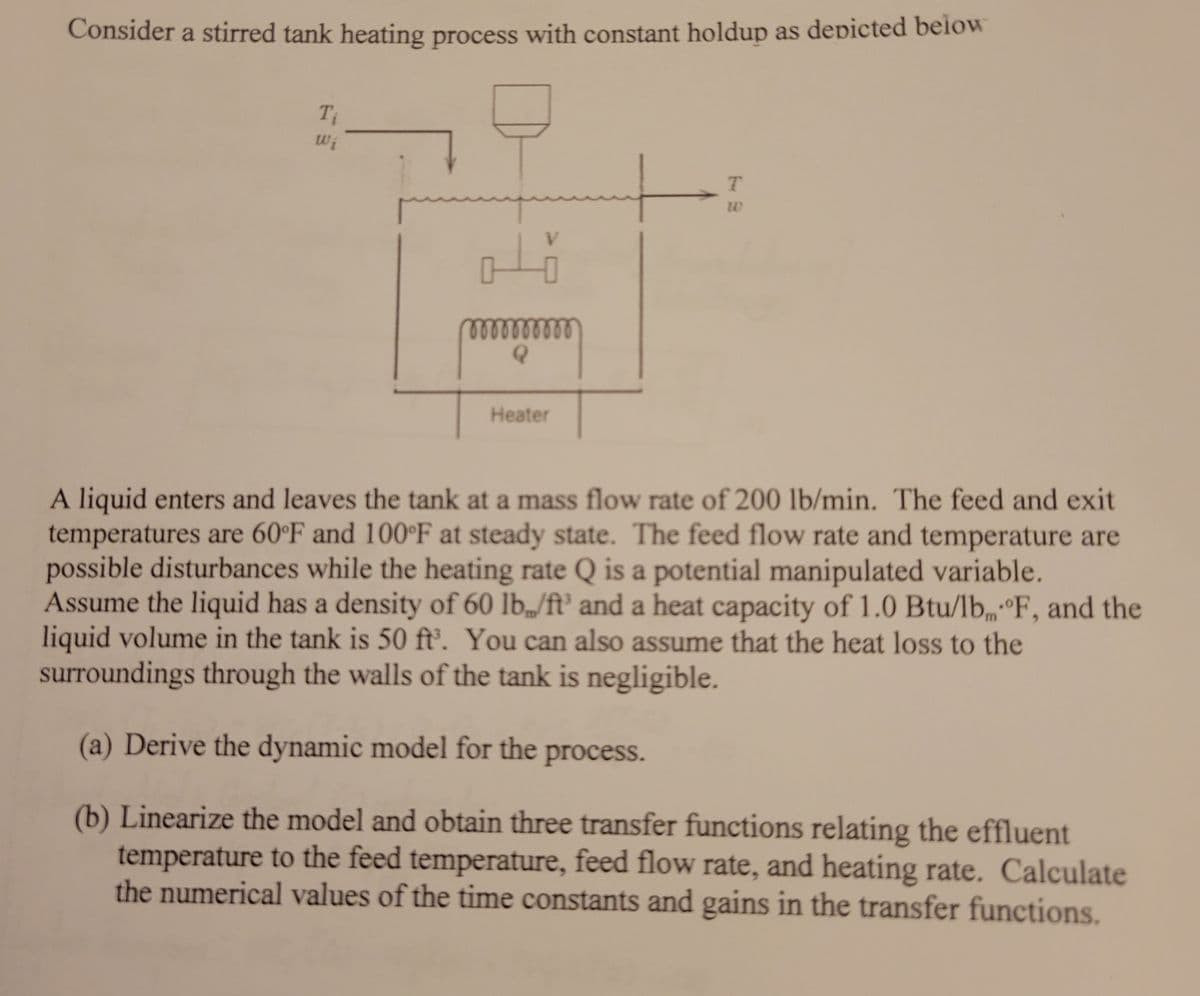Consider a stirred tank heating process with constant holdup as depicted beiow Ti Wi Heater A liquid enters and leaves the tank at a mass flow rate of 200 lb/min. The feed and exit temperatures are 60°F and 100°F at steady state. The feed flow rate and temperature are possible disturbances while the heating rate Q is a potential manipulated variable. Assume the liquid has a density of 60 lb„/ft' and a heat capacity of 1.0 Btu/I.°F, and the iquid volume in the tank is 50 ft'. You can also assume that the heat loss to the surroundings through the walls of the tank is negligible. (a) Derive the dynamic model for the process. (b) Linearize the model and obtain three transfer functions relating the effluent temperature to the feed temperature, feed flow rate, and heating rate. Calculate the numerical values of the time constants and gains in the transfer functions.
Consider a stirred tank heating process with constant holdup as depicted beiow Ti Wi Heater A liquid enters and leaves the tank at a mass flow rate of 200 lb/min. The feed and exit temperatures are 60°F and 100°F at steady state. The feed flow rate and temperature are possible disturbances while the heating rate Q is a potential manipulated variable. Assume the liquid has a density of 60 lb„/ft' and a heat capacity of 1.0 Btu/I.°F, and the iquid volume in the tank is 50 ft'. You can also assume that the heat loss to the surroundings through the walls of the tank is negligible. (a) Derive the dynamic model for the process. (b) Linearize the model and obtain three transfer functions relating the effluent temperature to the feed temperature, feed flow rate, and heating rate. Calculate the numerical values of the time constants and gains in the transfer functions.
Introduction to Chemical Engineering Thermodynamics
8th Edition
ISBN:9781259696527
Author:J.M. Smith Termodinamica en ingenieria quimica, Hendrick C Van Ness, Michael Abbott, Mark Swihart
Publisher:J.M. Smith Termodinamica en ingenieria quimica, Hendrick C Van Ness, Michael Abbott, Mark Swihart
Chapter1: Introduction
Section: Chapter Questions
Problem 1.1P
Related questions
Question

Transcribed Image Text:Consider a stirred tank heating process with constant holdup as depicted beiow
Wi
V.
lelllll
Heater
A liquid enters and leaves the tank at a mass flow rate of 200 lb/min. The feed and exit
temperatures are 60°F and 100°F at steady state. The feed flow rate and temperature are
possible disturbances while the heating rate Q is a potential manipulated variable.
Assume the liquid has a density of 60 lb„/ft' and a heat capacity of 1.0 Btu/lb°F, and the
liquid volume in the tank is 50 ft. You can also assume that the heat loss to the
surroundings through the walls of the tank is negligible.
(a) Derive the dynamic model for the process.
(b) Linearize the model and obtain three transfer functions relating the effluent
temperature to the feed temperature, feed flow rate, and heating rate. Calculate
the numerical values of the time constants and gains in the transfer functions.
Expert Solution
This question has been solved!
Explore an expertly crafted, step-by-step solution for a thorough understanding of key concepts.
This is a popular solution!
Trending now
This is a popular solution!
Step by step
Solved in 4 steps with 1 images

Recommended textbooks for you

Introduction to Chemical Engineering Thermodynami…
Chemical Engineering
ISBN:
9781259696527
Author:
J.M. Smith Termodinamica en ingenieria quimica, Hendrick C Van Ness, Michael Abbott, Mark Swihart
Publisher:
McGraw-Hill Education

Elementary Principles of Chemical Processes, Bind…
Chemical Engineering
ISBN:
9781118431221
Author:
Richard M. Felder, Ronald W. Rousseau, Lisa G. Bullard
Publisher:
WILEY

Elements of Chemical Reaction Engineering (5th Ed…
Chemical Engineering
ISBN:
9780133887518
Author:
H. Scott Fogler
Publisher:
Prentice Hall

Introduction to Chemical Engineering Thermodynami…
Chemical Engineering
ISBN:
9781259696527
Author:
J.M. Smith Termodinamica en ingenieria quimica, Hendrick C Van Ness, Michael Abbott, Mark Swihart
Publisher:
McGraw-Hill Education

Elementary Principles of Chemical Processes, Bind…
Chemical Engineering
ISBN:
9781118431221
Author:
Richard M. Felder, Ronald W. Rousseau, Lisa G. Bullard
Publisher:
WILEY

Elements of Chemical Reaction Engineering (5th Ed…
Chemical Engineering
ISBN:
9780133887518
Author:
H. Scott Fogler
Publisher:
Prentice Hall


Industrial Plastics: Theory and Applications
Chemical Engineering
ISBN:
9781285061238
Author:
Lokensgard, Erik
Publisher:
Delmar Cengage Learning

Unit Operations of Chemical Engineering
Chemical Engineering
ISBN:
9780072848236
Author:
Warren McCabe, Julian C. Smith, Peter Harriott
Publisher:
McGraw-Hill Companies, The